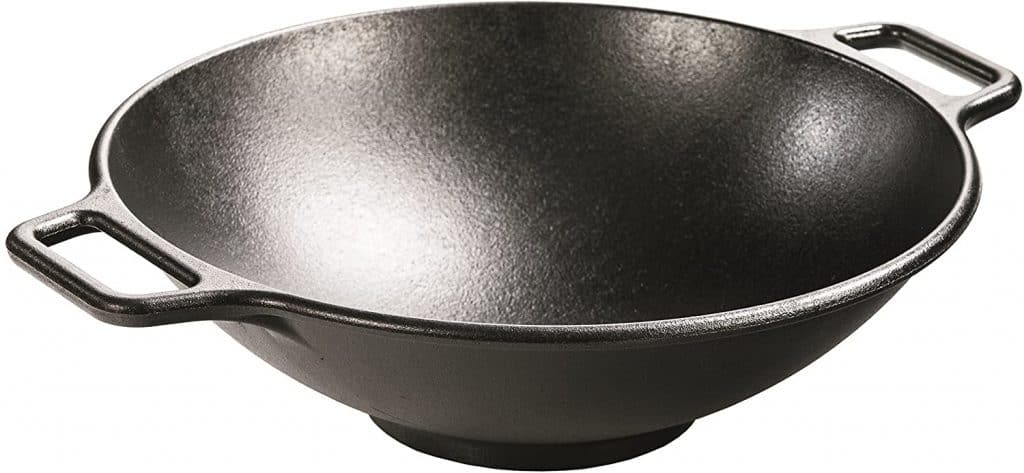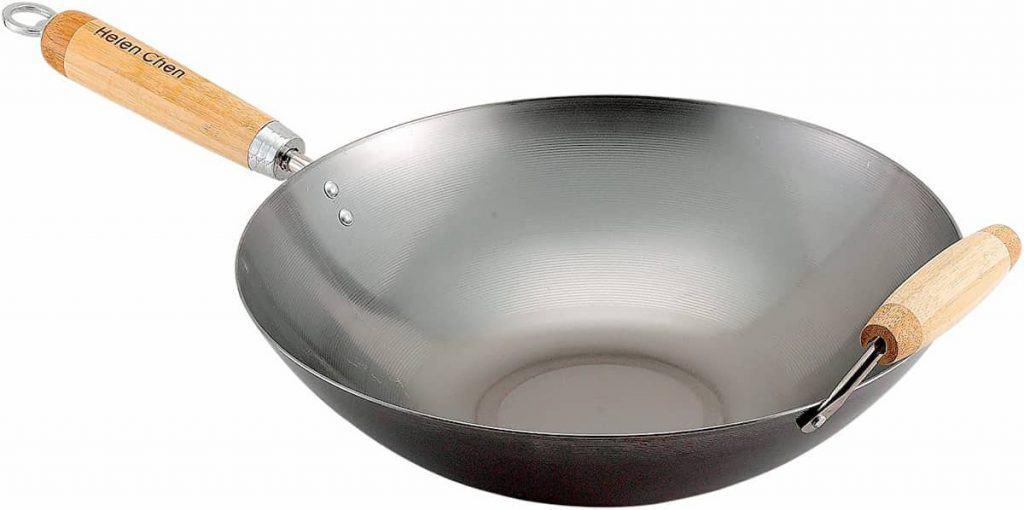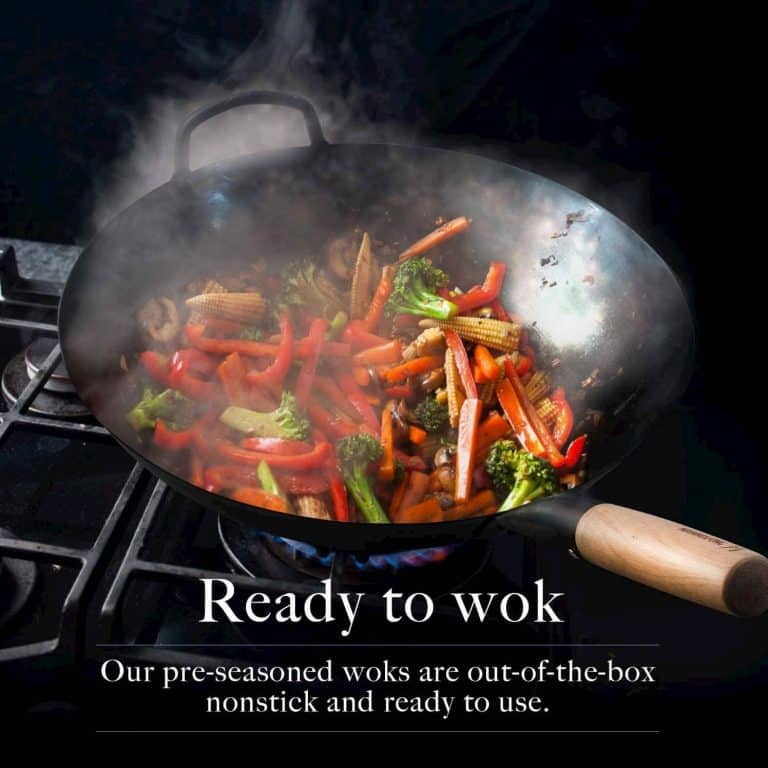
If you plan on using your wok on a flat surface, like an electric coil, or an electric glass, ceramic, or induction cooking surface, it would be best to use a flat-bottomed wok.
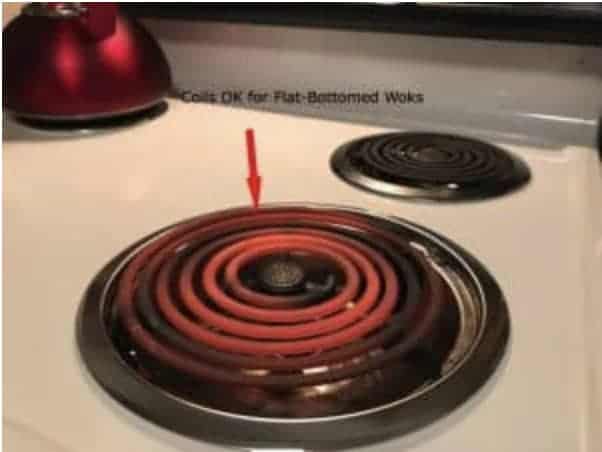
I live in a neighborhood where a lot of families use a grill or a wok on the weekends. In fact, there are three families on my short block who all use woks.!
Some of them use wok burners, and others just put their flat-bottomed woks on the open grill. It seems that most of the woks used on the grill are of the flat-bottom design rather than the round-bottom.
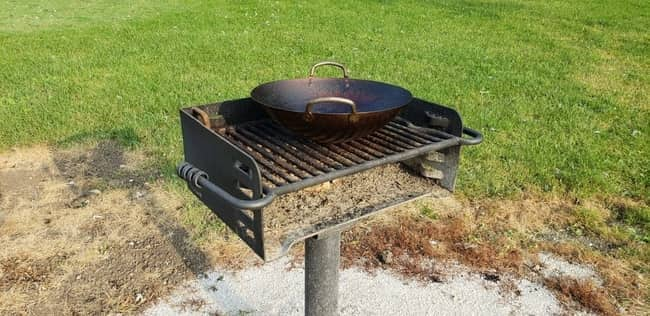
I did not know the cooking differences between the flat-bottomed wok and the round-bottomed wok. So, this started my “rabbit hole” investigation on why people use a flat-bottomed wok.
Here is what I learned:
- Flat-bottomed woks are more stable on a flat surface than a round-bottomed wok.
- Flat-bottomed woks distribute heat to the bottom of the pan more evenly than round-bottomed woks, if used on a flat cooking surface.
Wok Usage on Flat Surfaces
The flat portion of the wok should make full contact with the cooking surface. A round-bottomed wok will only make one small connection with the stovetop. This will not be enough to use your wok effectively, because it will never get hot enough.
Using Woks on Induction Cookers or Stoves
Flat-bottomed woks are a perfect match for induction cooktops. Just make sure that the cooking surface of the induction stove covers the entire bottom of the wok. Make sure that the induction stove that you will be using is capable of achieving a high temperature. Most induction stovetops provide around 1800 watts of power.
Here are a few induction cooktops that I recommend.
Flat-Bottomed Wok Heat Distribution
If you are going to use a flat-bottomed wok on a glass-topped stove, you will find the heat distribution will be a little more uniform, as compared to using a round-bottomed wok on the same surface. A flat surface on a flat surface is always better than a round surface on a flat surface.
Things to Consider When Selecting a Flat-Bottomed Wok:
- size of the wok
- helper handles
- wooden or metal helper handles
- type of surface you will be cooking on
- the material the wok is made of
The Size of the Wok Depends on…
- how many people you will be cooking for;
- size of your burners.
The standard size that most people use is 14 inches in diameter. A few of the woks are 12-inches in diameter. The Helen Chen line of woks can be purchased in the 12-inch size. Click here to see these woks on Amazon.
If you are preparing a dish for 8 or more people, you might consider getting a wok larger than 14 inches. If you are going to cook a large cut-up chicken plus vegetables, a wok larger than 14 inches might be needed.
If you only have a small burner under your wok, you do not want a wok with a large, flat bottom. Usually, it is desirable to have the flat surface of the wok be slightly smaller or the same size as the burner beneath it. This will allow for more evenly distributed heat.
Pre-Seasoned Flat-Bottomed Woks
If you are looking for a solid pre-seasoned flat-bottomed carbon-steel wok then I can recommend only one for you to take a look at. The Mammafong POW wok would be an excellent choice. The picture of the wok at the very top of this page is the Mammafong wok! Click here to see more about it at Amazon.
Helper Handles
Helper handles are not a critical factor in determining your wok purchase. However, they are a handy addition to any wok. One large handle is standard, but the extra, smaller handle is very beneficial.

Metal or Wooden Helper Handles
If you have limited space to store your wok, as I have, then you might consider the smaller, metal helper handles. They take up less space than wooden ones. On the other hand, wooden handles don’t get as hot as the metal ones, and you usually do not have to use oven mitts to manipulate your wok. If you can get bamboo handles instead of wood, they are even better, because they do not get as warm as the wooden ones.
Types of Cooking Surfaces
A flat-bottomed wok will work on most cooking surfaces. They can work well on induction stoves, electric glass stoves, gas stoves, rocket stoves, and even outdoor grills. Flat-bottomed woks don’t wobble around like round-bottomed woks.
Wok Materials
Woks may be constructed of stainless steel, cast iron, or carbon steel, and they may or may not have a non-stick coating.
Below is an example of a flat-bottomed cast iron wok with helper handles.
Stainless steel woks have a sticking problem, and they are costly. Coated or non-stick woks have the potential to add toxins to your food, and the non-stick surface doesn’t last very long.
In my experience, carbon steel or cast iron woks are the best ones to use. They both hold the heat well, and both can be non-stick, depending on how well you season them.
If you are considering a flat-bottomed cast-iron wok, I recommend the pre-seasoned cast-iron wok by Lodge. These woks are very heavy. The weight is about 11.6 pounds. They work well on all kinds of cooking surfaces, such as gas stoves, electric coil stoves, porcelain or electric glass-topped stoves, etc.
These woks hold their heat well and are reasonably priced. These cast iron woks have a flat bottom that contacts the cooking surface, but the inside of the wok is round. You get the best of both worlds with this wok. This inside round portion of the wok is excellent for stir-frying. Check the availability at Amazon.
The only drawbacks to these cast-iron woks are:
- You do not want to drop them on your foot or stove top…they will break both.
- You do not want to drop them on the floor. The floor may survive, but the cast iron probably won’t.
- You will probably need to go to the gym to exercise your biceps because they are heavy (11.6 pounds).
- The helper handles get very hot, so you will need to wear oven mitts to keep from frying your fingers and hands.
Carbon steel woks, on the other hand, do not break if you drop them, and they are not as heavy. Carbon steel cookware is not as brittle, because it only contains about 1-2% carbon. Cast iron has a higher ratio of carbon to iron.
More Information about Flat-Bottomed Woks
Most woks sold in western countries have flat bottoms—this makes them cook differently than round-bottomed woks. Flat-bottomed woks are more similar to a deep frying pan, because of the shape of the wok bottom. Flat- bottomed woks work with all types of stoves because the bottom is able to make contact with the stoves’ heating elements or flames.
With a flat-bottomed wok, it is a little more challenging to use a traditional wok spatula or ladle to toss or pick up food. This inability to wholly manipulate food with a spatula or ladle is because the spatula is round at the leading edge. This rounded leading edge conforms to the round bottom of the round-bottomed wok but does not follow or fit the flat-bottomed wok.
The flat-bottomed wok does not get as hot as the round-bottomed wok, because of the shape. This could affect your stir-frying capabilities. If the food at the bottom of your flat-bottomed wok is allowed to sit for any length of time without high heat and constant stirring, the food could be stewed instead of being stir-fried.
I like the carbon steel Helen Chen flat-bottomed wok above because it has two wooden assist handles and a smaller flat bottom. Check it out at Amazon.
If the flat portion of the wok is large, there is a possibility that the wok bottom may warp if high heat is applied.

I say most because there are a few hand-hammered flat-bottomed woks, as shown in the picture below that are available from Amazon. Notice how large the flat portion of the wok is. What I do not like about this wok is the size of the flat bottom. There is a high probability that the flat portion of this pan will warp when applying high heat. Once the bottom distorts, it will not lay flat on your stovetop. You will get uneven cooking, and it will most likely wobble.
This would not be my first choice in flat-bottomed, hand-hammered woks. If you like this particular wok, make sure you bring up your heat slowly to prevent warping. However, please realize that it might still warp, depending on how thick the metal is. The thicker the wok metal, the less likely it will warp. I understand, from my research, that this wok has a wall thickness of only 1.6mm, which is pretty thin for a carbon steel wok.
The only thing I like about this wok is that it has a wooden handle that can be removed during the seasoning process. Other than that, I cannot recommend this wok as being the best selection for your cooking needs.
Below are some examples of flat-bottomed hand hammered woks that I would recommend.
A Better Inexpensive Wok Recommendation
I highly recommend a wok such as the Helen Chen flat-bottomed wok if you are looking for an inexpensive 14-inch wok. Check out the availability at Amazon. Although this wok is not hand-hammered I like it because it is the right size and has two wooden helper handles. The Helen Chen wok comes in two sizes, the 12-inch, and the 14-inch size. I have the 12-inch wok (see above) and love it because when I cook for myself it is a perfect size.
Recommended Reading
What is the Best Oil to Use With a Wok?
Using the right oil for your stir-fry is the first step to a wonderful dish. No matter what oil you choose, try to use organic oil which does not have any GMO ingredients.
What Should My Wok Patina Look Like?
Your wok will change color over time to light brown (tan) then dark brown and eventually black. These patina changes help to season your wok. It is a Good Thing!
A Few Things You Didn’t Know About Buying a Wok
There are many types of woks and selecting the right one will enhance your cooking experience. It is essential to purchasing a wok that fits your requirements, preferences, and style of cooking.
Advantages of a Wok
One of the main advantages of using the Asian-style wok for cooking is that it is considered to be a healthier alternative to cooking with the traditional frying pan.
Why Use a Wok With a Round Bottom?
Round-bottomed carbon steel and cast iron woks are the preferred woks that are used by professional chefs. Round-bottomed woks are made of carbon steel, cast iron or stainless steel.
Cast Iron Wok Stands vs Wok Rings?
Cast iron wok rings will solidly support your round-bottomed wok or your flat-bottomed wok. Cast iron wok stands are not made for electric stovetops either ceramic/glass tops or electric coil tops.
